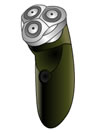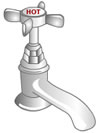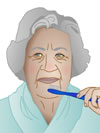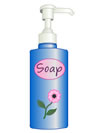| Checklist |
Tips |
Equipment

|
- When washing at a sink or basin make sure you are ready and have all you are going to need close by.
- Use a large mirror to help the person check what they have done so far and what they still need to do.
- A hand sized sponge is usually easier to squeeze out one handed than a toweling face cloth.
- Pump action soap or toothpaste dispensers are easier to use one handed.
- Men can try using an electric shaver which is easier than a wet shave with a razor. Some electric shavers have a built in balm dispenser and can be used wet or dry. Electric shave is safer especially if they have visual or perceptual problems or if coordination of movement is affected. As the coordination improves they can then attempt a wet shave. Use shaving foam and a mirror. Do this very slowly for the first attempt. Emphasise slow downward strokes.
- Use a large handled brush or comb for better grip.
|
Safety

|
- Check the water temperature if the person has poor sensation or get them to check for themselves by using the unaffected hand. If the person is very slow when washing they may need to top up with more warm water.
- Make sure they are sitting in a balanced position and that they don’t have to over reach to get items.
- Make sure the person is sitting in a supported position well back on their chair. A chair with arms is best. This is important when they need to bend forward to wash or dress lower body.
- Try not to rush the person. Give them time to work out how best to complete the task. If they are more relaxed they will tend to perform better and recover quicker.
- If they have balance problems when bending forward it is usually safer to wash and dress the lower body while the person is still lying on a bed. They may be able to roll from side to side to help you when washing or pulling up lower garments a little at a time.
- Let the person attempt the task but if they are getting fatigued, try breaking the task into different stages and build up gradually until they can achieve more for themselves.
|
Giving Assistance

|
- It is usually a good idea for the person to have used the toilet before they begin washing and dressing.
- If the person has movement in their affected side, encourage them to use it. Some tasks can be done using both hands even if one is weaker than the other. Use the weaker hand to stabilise the object and the unaffected hand for strength or fine hand movements.
- Be aware of hand and underarm washing and drying especially if the person has a problem with increased tight muscles and spasticity. They may need help to open the hand or to ease the arm away from the side of the body to clean and dry these areas thoroughly.
- Don’t forget about mouth care. Check the person is cleaning both sides of the mouth.
- When the person is washing their lower body make sure they wash and dry the groin area well. You may need to assist them to stand and balance while they do this. Keep the chair behind them so they can sit if the feel unsteady. Some people will be safer in the standing position if they are able to hold onto a rail or the side of the sink while the carer washes the lower half. Ask the therapist which method they recommend.
|
Tips and Techniques

|
- Try opening jars, toothpaste etc by putting between the knees and using unaffected hand.
- Try using the unaffected hand for washing under both armpits. By using a sponge “monkey style” ( for example using the right hand to wash under the right armpit) they should be able to wash and dry for themselves.
- Try squeezing toothpaste onto the side of the sink with the unaffected hand then scoop it onto the toothbrush.
- Try adding liquid soap or shower gel to the water rather than using a slippery bar of soap.
|